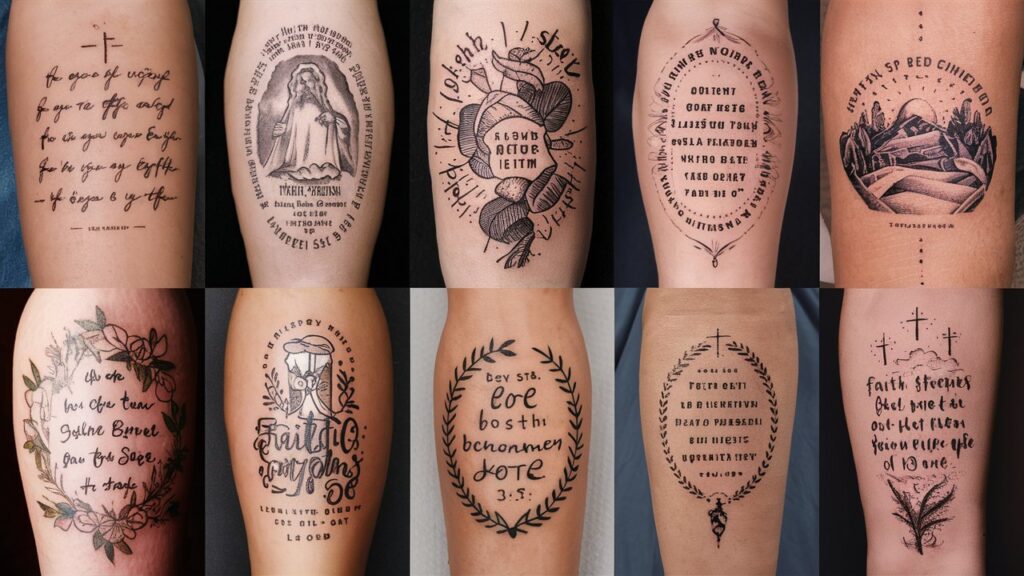Introduction
In recent years, tattoos inspired by scripture have surged in popularity as individuals seek to carry their faith with them in a deeply personal and artistic way. Bible verse tattoos are more than just body art—they serve as daily reminders of hope, strength, and spiritual connection. Whether you’re drawn to a single verse, a symbolic image paired with text, or a minimalist design, these tattoos allow you to express your beliefs in a form that resonates with your journey. This article dives into creative Bible verse tattoo ideas, their meanings, and practical considerations to help you craft a design that reflects your faith and story.
1. Popular Bible Verse Tattoo Ideas for Spiritual Expression
When choosing a Bible verse for a tattoo, many opt for passages that have profoundly impacted their lives. John 3:16 (“For God so loved the world…”) remains a timeless favorite, symbolizing divine love and sacrifice. Philippians 4:13 (“I can do all things through Christ…”) is another popular choice, often inked by those seeking courage or perseverance. For comfort during trials, Psalm 23:4 (“Though I walk through the valley…”) offers solace, while Jeremiah 29:11 (“For I know the plans I have for you…”) inspires trust in divine purpose. Each verse carries layers of meaning, making it essential to select one that aligns with your personal narrative and spiritual goals.
2. Symbolism and Imagery: Enhancing Bible Verse Tattoos
Incorporating religious symbols with Bible verses elevates the visual and emotional impact of the tattoo. A cross paired with Romans 8:28 (“All things work together for good…”) underscores redemption, while a dove alongside Galatians 5:22-23 (“Fruit of the Spirit…”) represents peace and the Holy Spirit. For nautical themes, an anchor with Hebrews 6:19 (“Hope as an anchor for the soul…”) merges faith with resilience. Even subtle imagery like a olive branch or fish symbol (Ichthys) can add depth to your design, creating a harmonious blend of text and art that speaks to your heart.
3. Placement Ideas: Where to Ink Your Scripture Tattoo
The placement of your Bible verse tattoo often reflects its significance. Forearm or wrist placements allow for visibility, serving as constant reminders of your faith—ideal for shorter verses like Proverbs 3:5 (“Trust in the Lord…”). Larger passages, such as Isaiah 41:10 (“Fear not, for I am with you…”), may flow elegantly along the ribcage or spine. For intimacy, consider the collarbone or behind the ear, where a tiny “Be still and know” (Psalm 46:10) can offer quiet encouragement. Discuss sizing and readability with your artist to ensure the text remains legible over time, especially for intricate scripts.
4. Design Styles: From Minimalist to Ornate
Your tattoo’s aesthetic should mirror your personality. Minimalist designs with clean lines and small fonts suit subtle verses like Matthew 6:33 (“Seek first the kingdom…”). Script or calligraphy styles add elegance to longer passages, while watercolor backgrounds can infuse color into themes of renewal, such as 2 Corinthians 5:17 (“A new creation…”). For a bold statement, blackwork or traditional Americana styles frame verses like Joshua 1:9 (“Be strong and courageous…”) with striking contrast. Don’t shy away from customizing fonts or adding floral vines, stars, or geometric patterns to make the design uniquely yours.

5. Personal Stories: Why Bible Verse Tattoos Matter
Behind every Bible verse tattoo is a story of transformation, loss, hope, or gratitude. Sarah, a breast cancer survivor, chose Isaiah 43:2 (“When you pass through the waters…”) as a testament to her resilience. Mark, a veteran, inked Psalm 18:2 (“My rock and my fortress…”) on his shoulder to honor his faith during service. These tattoos often mark milestones—a recovery, a renewed faith, or a tribute to a loved one. By choosing a verse that mirrors your journey, the tattoo becomes a wearable testimony, sparking conversations and inspiring others.
6. Cultural and Religious Perspectives on Scripture Tattoos
While Bible verse tattoos are widely embraced, some religious communities debate Leviticus 19:28’s caution against markings. However, many modern believers view them as acts of devotion rather than defiance. In cultures where tattoos are stigmatized, discreet placements help balance self-expression with respect. Conversely, in regions like Latin America or the Philippines, religious tattoos are celebrated as public declarations of faith. Understanding your cultural context and personal convictions ensures your tattoo aligns with both your beliefs and community values.
7. Choosing the Right Verse: Practical Tips
Selecting a Bible verse for a tattoo requires reflection. Ask yourself: Does this passage resonate with my core values? Will its meaning endure through life’s changes? Consult commentaries or pastors to grasp the verse’s context—for example, Romans 8:28 is often misunderstood without reading the surrounding text. Test-drive the design by writing the verse on your skin temporarily. Lastly, research artists experienced in script tattoos to ensure precision, as poorly spaced lettering can distort the message.
8. Tattoo Aftercare: Preserving Your Spiritual Art
A Bible verse tattoo’s longevity depends on proper aftercare. Follow your artist’s instructions: keep the area clean, moisturized, and shielded from sunlight. Avoid soaking in water (e.g., pools) during healing. Touch-ups may be needed for fine lines or fading over time. Remember, this tattoo is not just ink—it’s a lifelong emblem of your faith, so treat it with the same care as the spiritual journey it represents.
Conclusion
A Bible verse tattoo is more than a trend—it’s a deeply personal fusion of art and faith. By thoughtfully selecting a verse, design, and placement, you create a permanent reminder of God’s presence in your life. Whether bold or subtle, these tattoos carry stories of hope, resilience, and love, inviting others to reflect on the power of scripture. As you embark on this journey, let your ink be a testament to the verses that guide, heal, and define you.
Frequently Asked Questions (FAQs)
Q1: Do Bible verse tattoos hurt more depending on placement?
A: Pain varies by location. Bony areas like ribs or ankles tend to be more sensitive, while fleshy areas like the forearm are less so. Discuss pain management options with your artist.
Q2: Can I translate a Bible verse into another language for my tattoo?
A: Yes! Latin, Greek, or Hebrew translations add classical flair. Ensure accuracy by consulting a reputable translator to avoid errors.
Q3: How do I combine multiple verses into one design?
A: Use a thematic approach—for example, pair Psalm 23 and John 10:11 (“I am the Good Shepherd”) with a pastoral image. An artist can help weave text cohesively.
Q4: Are small Bible verse tattoos still impactful?
A: Absolutely. A tiny “Faith” from Hebrews 11:1 or a minimalist cross with Micah 6:8 (“Act justly…”) can hold profound meaning without size.
Q5: What if I regret my verse choice later?
A: Choose a verse tied to timeless truths rather than fleeting emotions. If needed, tattoos can be modified or covered with new designs that reflect growth.
This comprehensive guide equips you to create a Bible verse tattoo that’s both visually stunning and spiritually significant. Let your ink tell a story that transcends skin—a story of faith, hope, and eternal love.
